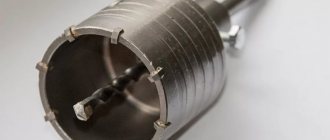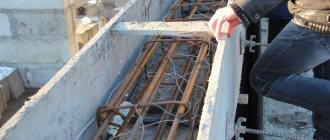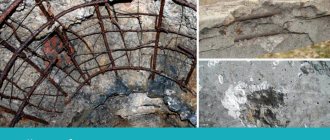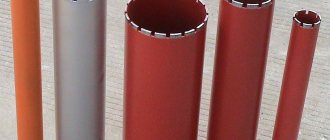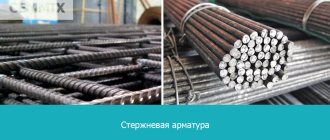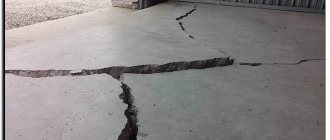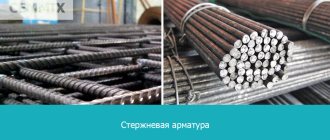A transformer is used by builders to heat concrete in the winter. During this period, pouring structures from a cement mixture is possible only with artificial heating of the materials. In this case, the concrete hardens in accordance with established standards, which allows repair and construction work to be carried out on time. What are transformers and substations for heating concrete, their technical characteristics and description will be discussed further.
Warming up concrete with a welding machine and PNSV wire
The operating scheme here is exactly the same as when using oil transformers.
All the subtlety is in the calculations. So, to heat concrete with a welding transformer along with a wire, we will need a 150-250 A welder, a PNSV cable, an aluminum cold-end cable, an ammeter (pliers) and fabric-based electrical tape. As an example, I will give a calculation for heating a 3.8 m3 slab measuring 4x5x0.19 m at an air temperature of about -12°C and a 250 A welding machine. So, we cut the PNSV wire into sections 18 meters long. The length was determined empirically and may be different for your case. Each of these segments is capable of withstanding a current of up to 25 A. Accordingly, for a total of 250 amperes it is possible to use 10 segments. But in order not to go to extremes and leave a small margin, we will focus on 8 wires.
To each piece of PNSV we screw an aluminum wire on both sides of such a length that the twist itself is in the concrete and the cold ends reach the transformer. We insulate the twist itself with electrical tape.
We lay the pieces of wire, tying them to the fittings with plastic fasteners or insulated wire to avoid short circuits. For a slab, the wire can be fixed just below the top reinforcing layer. The outputs of each wire must be marked, for example (+) and (-). Or you can separate the ends on different sides of the structure. It is also very convenient to connect the phases (pluses separately, minuses separately) to each other on an insulated surface (textolite) with terminals.
After pouring the concrete, we immediately connect our terminals to the forward and reverse outputs of the welding machine, set to the minimum current. We measure the current on the welding wires (should be up to 240 A) and on each segment (should be up to 20 A). As it heats up, the current will drop and will need to be increased on the device.
As a result, a slab of these dimensions acquired the required strength in 40 hours. Also, after pouring concrete, it is recommended to cover it with a protective film to prevent drying out. At particularly low temperatures, a layer of insulation can be placed on top of the film.
A video on laying PNSV wire can be viewed below:
Maintenance of oil transformers
With a focus on maintenance, oil-containing models are subject to periodic oil analysis in addition to cleaning and general inspection of operating components. Repairing an oil-immersed transformer is considered less expensive. Oil requires regular monitoring and replacement.
Modern technologies make it possible to purify used oil and reuse it. The process of changing or cleaning the oil must be in accordance with the instructions and operating instructions of the transformer. In addition to cleaning and oil regeneration, the insulation system may need to be dried and degassed. Moisture and gas, as well as other impurities, are harmful to the entire transformer station and must be removed as soon as their presence is detected.
Principle of operation
A step-down transformer for heating concrete is a device that provides power to electrodes or a heating cable from a single- or three-phase network. It is enclosed in a steel casing, and is equipped with cooling systems, automatic control and a control panel.
Alternating current from the network is supplied to the high-voltage coil, according to the law of electromagnetic induction through the magnetic circuit, it excites a low-voltage EMF in the secondary low-voltage coil, which withstands high currents. Heating electrodes or a special heating cable are connected to the terminals.
The control unit regulates the output power required for normal operation of the electric heating system when the air temperature changes. A fuse is installed in front of the high-voltage coil; it will be needed to turn off the equipment if the heating transformer for concrete is overloaded, or if there is a risk of a short circuit. To monitor the operation of the low voltage coil, an ammeter is included in its circuit.
The connection of a transformer and the operation of the entire system is based on the property of a conductor to generate heat when current passes through it. First, the formwork is installed, in which the reinforcement frame is welded. Then the PNSV heating wire with a cross section of 1.2 mm is laid out on it, although there are other options, but this one is cheap and practical. The cold ends are brought out, after which the construction mixture is poured and compacted.
After pouring the solution, the cable is connected to a station (transformer) for heating the concrete, and warms it up to 80ºC at a speed of no more than 10ºC per hour. In this case, the heating time of the concrete mixture depends on the ambient temperature. The ammeter of the low voltage winding all this time shows a current of 14-16 A. After reaching the maximum temperature, it is lowered to 40ºC by no more than 5ºC per hour and held until the monolith reaches critical strength.
When heating with electrodes laid as reinforcement, the heating principle is similar to wired systems. The structures, which are electrodes, are connected to the transformer through a special cable. During operation, monitor the current in the low-voltage winding, since as concrete hardens, the electrical resistance increases and the current decreases.
Criterias of choice
When choosing a transformer for heating concrete, it is necessary to take into account the size of the structure being built. In addition, the degree of insulation and ambient temperature are of considerable importance.
For example, if construction work is planned to be carried out during not very cold weather, then you can use a less powerful, and, therefore, cheaper device.
When choosing a transformer, first of all you should pay attention to its power. After all, the time it will take to complete a certain amount of work depends on this characteristic.
If the need to heat concrete occurs quite rarely (for example, no more than once a year), it is more profitable not to buy a transformer station, but to rent it. In this case, you can not only save a lot of money, but also select the required power, as well as determine other technical parameters of the device for the implementation of a specific construction project. You can rent the equipment for a day by paying a certain amount for it (usually about $15). Of course, you can rent a device for a longer period of time, but then the total cost will increase.
Transformer TSDZ-63
This device has 3 different low voltage settings. It must be connected to a network with a voltage of 380 V and a frequency of 50 Hz. It can work without interruption for quite a long time both at 45 degrees below zero and at temperatures of plus 20 degrees.
The advantages of this transformer station also include its light weight and small size. The machine prevents failure due to sudden voltage surges and short circuits in the network. Before connecting the unit to the network, it is necessary to ground it.
Model KTPTO-80
This design is an oil-immersed 3-phase transformer. It has 5 voltage switching stages (minimum - 55 V, maximum - 95 V). The equipment can be connected to a network with a voltage of 380 V and 42 V.
The KTPTO-80 station is widely used by construction organizations. Its main advantages include reliability, low price and high quality of work.
Transformers for heating concrete have helped many people build strong and durable concrete structures during the harsh winter. After all, if in a slight frost of just minus 5 or minus 10 degrees, special components added to the mixture can still help out, then when the thermometer drops below 25 degrees, the only thing you can rely on is the transformer station.
Heating concrete with electrodes - connection diagram
Heating concrete with electrodes is the most common method of electrical heating in winter. This is due, first of all, to simplicity and low cost, because, in some cases, there is no need to spend money on heating wires, expensive transformers, etc.
The operating principle of this method of electric heating is based on the physical properties of electric current, which, when passing through the material, releases a certain amount of heat.
In this case, the conductive material is the concrete itself, in other words, when a current passes through the water-containing concrete, it heats it up at the same time.
Attention! If the concrete structure contains a reinforcement frame, it is not recommended to apply a voltage of more than 127 V to the electrodes. In the absence of a metal frame, you can use both 220 V and 380 V
It is not recommended to use higher voltage.
There are several types of electrodes for heating concrete in winter:
Rod electrodes. To create them, metal reinforcement d 8 – 12 mm is used. Such rods are inserted into concrete at a short distance and connected to different phases, as in the diagram. In cases of complex structures, such electrodes for heating concrete will be indispensable. Fiberglass reinforcement is not suitable for such purposes, because it is a dielectric.
Electrodes in the form of plates. They are sometimes called plate electrodes. The connection diagram for such heating is very simple - the plates are located on both opposite inner sides of the formwork and are connected to different phases, and the passing current will heat the concrete. Instead of wide plates, narrow strips are sometimes used; the principle of operation of these strips is the same.
String electrodes. Used when pouring columns, beams, pillars and similar structures. The principle of operation is still the same, the strings are connected to different phases, thereby heating the concrete in winter.
Heating of concrete with electrodes must be carried out only with alternating current, since direct current passing through water promotes its electrolysis. In other words, water will chemically decompose without fulfilling its main function during the hardening process.
Heating modes for concrete electrodes
When choosing modes, there are a number of factors to consider, including:
- Dimensions and geometric design features.
- Brand of concrete.
- Operating conditions of the building.
In modern construction, the following schemes for heating concrete with electrodes are practiced:
- 2 stages: heating of concrete with isothermal exposure;
- 2 stages: heating of the structure, followed by cooling and thermal insulation exposure (even when using this scheme, you can install a heating formwork);
- 3 stages: involves heating, isothermal holding and cooling of the material.
Regardless of the method used, it is necessary to monitor the temperature values and start work at +5 ℃, gradually raising the temperature at a frequency of 8-15 ℃ per hour. Acceptable values are +55…+75 ℃. To prevent deviations, it is necessary to measure the temperature regularly.
The duration of isothermal exposure is selected taking into account laboratory analysis of compressive strength. The exact information depends on the type of cement, heating temperature and expected strength of the material.
Cooling of concrete is allowed at a rate of 5-10 ℃ per hour. As at the concrete heating stage, here it is necessary to take into account the volume of the structure and its purpose.
The most common problems when operating equipment for heating concrete
As a result of natural wear and tear, which occurs even if the units are used correctly, breakdowns occur, the most typical of which are:
- Failure of the oil transformer switch. Such a switch is located in an oil environment, so repairing or replacing it requires a complete stop of the device and drying it after draining the oil.
- Short circuit of windings. The consequences are burnout of the AV and wires located in the cabinet.
- Failure of busbars in the control cabinet. This may occur due to unprofessional cable connections.
The following problems may occur in dry-type transformers:
- Failure of cooling system fans.
- AB malfunction.
- Failure of monitoring, measuring, and control devices.
It is advisable to entrust the current and major repairs necessary to restore the functionality of transformers for heating concrete to the professionals of service centers equipped with modern diagnostic and repair equipment.
Oil type transformer station insulation
An oil-type transformer unit consists of external and internal insulation of liquid and solid types:
- External insulation is placed outside the transformer housing and is created due to air gaps between the housing and the bushing;
- Internal insulation: basic (from the grounded parts of the core, winding to the tank and between the windings) and longitudinal (between different points of the winding and turns) insulation.
The oil type insulation system of the transformer device for heating concrete is designed to protect bushings, windings, turns, switches and additional components. Modern models are equipped with combined insulation - insulating-type oil partitions partially combined with solid insulation in some parts. The combined system is able to provide complete and most effective insulation.
How does construction proceed in winter?
Winter is a period of low temperatures, so how does the construction of complexes of concrete structures take place at this time? After all, it is known that concrete is a mixture of gravel, sand, cement and water in a certain proportion. And the time during which the solution gains design strength is 28 days. We also know that when water freezes, it occupies a larger volume and can tear apart monolithic structures.
There are several ways to get around the temperature limitation, but they all boil down to one thing: maintaining the temperature of the solution above zero. If this standard is not observed, the erected structure will not be strong enough and will collapse very quickly. Below we will provide several popular methods for heating concrete at a construction site in winter.
Review of popular transformers
When choosing an electrical installation, you must take them into account:
- Design features.
- Power and number of voltage stages.
- How does the winding cool down? There are models with dry insulation, in which cooling occurs naturally (due to direct heat exchange with air), and there are also oil transformers that cool the winding using mineral oils. In addition, today there are units with a forced cooling system.
Let's consider a list of models that best meet these requirements.
https://youtube.com/watch?v=AXgOIRKILLlc
KTPTO 80-86
The KTPTO concrete heating station is a three-phase transformer for frozen soil and concrete mortar, with a power of 80 kW and a supply voltage of 380 V. The unit has an oil cooling system. The KTPTO transformer operates in automatic mode, so the operator does not need to constantly compare the readings of air temperature and heating power. The station operates in a temperature range from -40 to + 10 degrees. The area that the transformer is capable of heating is up to 40 m3.
If we talk about the advantages of the KTPTO 80 concrete heating transformer, the unit stands out:
- a fairly simple device;
- possibility of connecting third-party equipment.
Among the disadvantages of the unit:
- the dimensions of the station are too large;
- heavy weight (because of this, the transformer can only be moved on a skid).
- equipment requires maintenance every 3 months.
But today more modern stations have appeared on sale, which are compact and lighter in weight. Moreover, in modified models you can adjust the temperature both manually and automatically.
The cost of the transformer ranges from 125,000 to 180,000 rubles.
SPB-20
This three-phase concrete heating station has a dry-type cooling system and a rated power of 20 kW. The temperature range at which the unit performs its functions is from -40 to +5 degrees.
The SPB-20 concrete heating station is more suitable for small construction projects with an area of up to 20 m3, so it is recommended to use it for self-construction of buildings.
The advantages of the equipment include the following:
- facilitated wheeled transportation;
- increased reliability and protection against power surges.
Among the disadvantages:
During the adjustment process under network load, switches sometimes break down.
The cost of the station ranges from 49,000 to 61,000 rubles. You can also find a lower power model on sale - SPB-10, which will cost from 20,000 to 25,000 rubles. There are also more powerful units, for example, SPB-35 - SPB-100, but their use is rational only when we are talking about large areas. In addition, their cost will be from 60,000 to 160,000 rubles.
TSDZ-63/0.38
The next three-phase power unit, providing a power of 63 kW, is equipped with a forced ventilation system (built-in fan). The transformer is capable of operating in a wider temperature range from -45 to +20 degrees. In this case, the unit operates in uninterrupted mode.
Among the advantages:
- light weight, compact;
- equipped with an automatic switch.
Among the disadvantages, users highlight:
Frequent breakdowns of the cooling system, due to which the entire installation ceases to function.
TSDZ-63/0.38 costs from 61,000 to 79,000 rubles.
TSDZ-80/0.38 UZ
This mobile station also heats concrete mortar and frozen soil. The unit also has a forced cooling system, which operates thanks to two fans installed on the rear of the unit.
Positive sides:
- compactness;
- light weight;
- possibility of automated operation;
- high level of protection, due to which it is impossible to regulate the voltage during operation of the equipment.
However, this transformer has one significant drawback - if the station breaks down, it will be impossible to repair it.
The cost of a power transformer ranges from 70,000 to 100,000 rubles.
TSZP-80/0.38
This mobile unit is equipped with a natural cooling system. Its distinctive feature is that the concrete is heated by a transformer in 6 modes from 45 to 100 V.
The main advantages of the station:
- convenient transportation;
- compact size and light weight;
- possibility of self-repair.
There is only one drawback - the automation does not always work stably.
Such a power unit costs from 58,000 rubles.
Design features of dry and oil installation systems
The main reason why operators choose dry modifications over oil samples is to reduce costs. Models with a dry type of cooling design require minimal repairs or inspections than modifications with an oil system, since they do not use an insulating liquid. However, the lack of periodic maintenance of this equipment will lead to unforeseen consequences.
Many users claim that the operation of dry-type transformer devices is more stable, more efficient and safer than oil-based installations - both types of equipment differ in several fundamentally important factors.
Warming up concrete with a welding machine and electrodes
With this method, the heating elements are electrodes implanted into the concrete. And the current flows directly through the solution. This leads to the main disadvantage of heating the welding machine together with the electrodes: the danger of electric shock to nearby people. Voltage up to 36 V is considered safe. If it is higher, then care must be taken to prevent people and animals from entering the heated object. There is also an opinion that such reinforcing electrodes quickly wear out the welding transformer.
Electrodes (reinforcement rods) are laid in the structure, connected in series so that two segments isolated from each other are obtained. I connect the direct wire to one of them, and the reverse wire to the other. To control the current, an incandescent lamp is connected between the two electrodes (optional)
It is very important to measure the temperature of concrete to prevent dehydration and cracking. Don’t forget to cover the poured structure with film and insulation to avoid heat and moisture loss
Which type is right for you - oil or dry transformer
Oil-filled and dry-type transformer - both types are widely used for medium-scale power distribution. The benefits of each type come down to destination requirements, project/end user, transformer size/power requirements, losses and costs.
Dry type transformers are suitable for indoor use. Even if they are large and not convenient for space, compliance with fire safety rules is less stringent. In areas with higher load requirements and external power distribution, oil-filled units can be used.
To get the most out of both types, it is recommended to consider a liquid type transformer, which uses non-flammable or less flammable fluids. This will allow businesses to bypass certain fire safety regulations while still obtaining a reliable transformer station.
Types and characteristics of transformers
When choosing equipment for a construction site, it is necessary to take into account the power of the transformer and the voltage range in the output circuit. Additionally, the method of controlling the product is taken into account; there are installations with manual or automatic control. Some of the installations include panels for connecting external consumers (electric tools or lighting lamps).
Types of transformers for heating concrete:
- dry type, equipped with an air cooling system;
- oil units characterized by increased power and extended service life.
Regardless of the type of installation, the following rules must be followed:
- the equipment must be grounded before connecting external power;
- It is not allowed to work with the casing removed;
- When working, it is necessary to comply with PTE and PTB.
KTPTO 80
The installation has a power of 80 kW, the basic version has manual control. A unit for automatic adjustment of operating parameters can be installed as a separate order. The product design uses an oil transformer operating from a 3-phase network with a voltage of 380 V.
It is possible to change the output voltage in the range from 55 to 95 V, there are connectors for connecting a tool and organizing temporary local lighting. The cost of a new installation in Moscow starts from 120 thousand rubles.
SPB 20
The mobile unit is equipped with a wheeled chassis and front supports; air-cooled transformers are used to reduce the weight and dimensions of the structure. The equipment is designed to use an alternating current network with a voltage of 380 V, the power is 20 kW.
The product is designed to serve small construction sites; the power is enough to heat structures with a volume of up to 20 m³. The cost of the equipment is 59.3 thousand rubles.
TSDZ 63 0 38
A 63 kVA transformer for heating concrete has an output voltage in the range from 63 to 80 V. The installation weighs 310 kg, and the design uses dry-type transformers that allow operation of the equipment at temperatures from -40°C.
The product can be used to preheat frozen soil, which is then removed with an excavator bucket. The installation has a protection class of IP22, the design is not intended to work in vibration conditions, the cost starts from 58.6 thousand rubles.
TSDZ 80 038 UZ
The equipment is characterized by reduced dimensions and weight; it is installed at a construction site on steel supports; adjustment of the position of the legs is not provided. The transformer has a power of 80 kW, and fans are used to ensure reliable cooling.
Adjustment of operating parameters is carried out manually; an automatic version is provided. Both product options do not support voltage adjustments in the heating circuit. To switch the transformer, a 3-phase network is required, the cost of the equipment starts from 75.8 thousand rubles.
TSZP 80 0 38
The installation is distinguished by the use of a separate unit, which allows stepwise regulation of the voltage in the heating circuit (in the range from 45 to 100 V). The transformer is air-cooled, air circulation is carried out naturally. The weight of the unit is 340 kg, and steel skids are used for placement on the construction site.
The design of the equipment includes analog ammeters and protection against overheating using thermostats (permissible temperature 105°C).
Cooling system - oil or dry transformer
Manufacturers offer several types of transformers, which have their pros and cons. Generally speaking, for medium-sized transformers, units can be classified as oil-filled (liquid-state) or dry-state (solid-state). As the terms suggest, oil-immersed transformers use flammable liquids—usually mineral oil. Dry type transformers do not use flammable liquids and use durable insulation to ensure low operating temperatures.
At first glance, one can assume that dry-type blocks, being solid-state and not requiring flammable liquids, will be better than oil-based models. This is not always the case, as the oil unit type has efficient performance, is durable and has more reliable overload capabilities. However, oil-filled units come with their own set of limitations—oil-filled versions, for example, are not suitable for indoor use.
Low frequency transformer and concrete
Principle of operation
To fill monolithic structures at temperatures below -4? C, they resort to various methods of heating the cement mass, these are infrared emitters, heated mortar, warm formwork, and anode heaters. But the most effective and economical is heating the concrete using a low-frequency transformer and PNSV wire (Heating Wire Steel Vinyl Insulation).
Before connecting the transformer to heat up the concrete, loops of PNSV wire with a cross-section of 1.2 mm2 to 3 mm2 are laid on the reinforcement frame. This cable is capable of warming up to a temperature of 80? C, thus heating the solution to 40? C-50? C, and all this happens at an air temperature of -4? C and below. In order to achieve the most optimal heating of concrete in frosty conditions, about 60 m of PNSV-1.2 is needed per cubic meter of solution.
When laying the loops, be careful not to close the circuit; in other words, when you tie the wire to the reinforcement frame, its insulation (PNSV) can simply rub against the metal and the loop will burn out. Under such conditions, a certain area of the pour will remain without heating, which can lead to destruction of the unspecialized mass and, as a result, the reinforced concrete will be of poor quality (see also the article “Painting a cement fence: how to get a durable coating”)
For warming up, the instructions allow the use of transformers such as KTP-06-20, KTPTO-80, KTP-OB-160, TSDZ-63 and even then.
Oil transformer. Characteristics
| Transformer | KTPTO-80 | KTP-63-OB |
| Rated power (kVA) | 80 | 63 |
| HV voltage (V) | 380 | 380 |
| No-load voltage CH (V) | 49, 60, 70, 85, 103, 121 | 49, 60, 70, 85, 103, 121 |
| MV side current at voltage | 660 (49-70V, A) | 520 (49-70V, A) |
| MV side current at voltage | 382 (85-103-121V, A) | 301 (85-103-121V, A) |
The transformer is dry. Characteristics
| Transformer | TSZ-20 |
| Rated power (kVA) | 20 |
| Nominal frequency (Hz) | 50 |
| Number of phases | 3 |
| Nominal winding voltage, transformer HV, LV V | 380/220 12,4; 24,8; 49,7;66,0 |
| Rated current of HV winding of transformer A LV | 30,4/52,6 465;375; 235;175 |
| No-load current (%) | 7,5 |
| Connection diagram/group | Star/delta |
| Circuit loss (W) | 400 |
| No-load loss (W) | 200 |
Preparing for work and launching
In order to more clearly imagine the connection cycle and operational start-up, below will be given instructions for the transformer for heating concrete KTPTO-80 (see also the article “Cement panels for fences - advantages and installation”).
All work on heating the poured concrete should be done in compliance with SNiP 111-4-80/chap.11 and GOST 12.1.013-7, which regulates the procedure for performing work and electrical safety.
First of all, the KTPTO needs to be zeroed, and this can be done by connecting the power cable (its fourth core) to terminal N of the XT6 block, thus connecting all this to the iron control cabinet. The transformer is grounded from the slide - there is a special bolt for connecting the circuit, and a steel wire of at least 4 mm is used for the connection
Before connecting the step-down transformer to the network, you need to check the insulation resistance with your own hands, which should not be less than 0.5 MOhm, and pay attention to the tightness of the contact connections. Position switches SQ1 and SQ2 must be installed so that when opening the cover of the transformer casing and control panel it is possible to reliably close contacts SQ1 and SQ2
In addition, it is imperative to check the fuses in case of a short circuit. We set the power transformer switch to 55V, which will correspond to position 1, and set the involuntary switch together with switch SA3 to the “OFF” position. Then the heating circuit installed in the formwork can be connected to the power cable, which, in turn, is connected to the HTB clamp block.
- We supply 380V power to the KTPTO input and turn on QF1 after checking the voltage according to HL1 and HL3 and then, using the emergency shutdown button SB1, we do a control shutdown, after which we start QF1 again. We supply power to KL1 with the SB3 button, after which the magnetic starter KM1 should operate.
- To switch operating modes, you need to lift the cover of the transformer casing and then QF1 will automatically turn off through the contact switch SQ1. Upon completion, switch the voltage levels and turn on QF1 and KM1.
PNSV wire
A universal and affordable way to warm up concrete in winter using a high-resistance cable and a step-down transformer. When linking the frame from the reinforcement, a heating cable is laid; the size and shape of the structure does not matter.
This heating method is applicable both at the construction site and for home builders. Let's tell you in a little more detail how to heat a concrete mixture with a PNSV wire at home.
After reinforcing the frame of the structure or laying the beacons under the self-leveling floor, the wire is laid in a snake no closer than 20 centimeters from each other (the optimal laying step). The length of one loop ranges from 28-36 meters. A welding machine can be used as a voltage source. The connection diagram in this case will look like this:
The nuance of warming up is that the PNSV cannot be connected without being covered with a solution, because Without heat absorption due to the high temperature outdoors, it will burn out. To avoid burnout, switch to an aluminum cable, leaving the output ends of the PNSV heating wire 10 cm out of solution. The manufacturer recommends a current in the cable of 11-17 amperes, which can be controlled with current clamps. We talked about how to use current clamps in a separate article.
For home construction, a PNSV with a diameter of 1.2 mm is sufficient. Its characteristics:
- resistance 0.15 Ohm/m;
- operating current immersed in solution 14-16 amperes;
- laying temperature from -25 to 50 °C.
Wire consumption per cube of concrete is 60 linear meters. The temperature to which concrete is heated is 80 °C, it is controlled by any thermometer. The rate of temperature rise of the solution should not exceed 10 degrees per hour. To avoid pointless expenses on electricity bills, the heated area is covered with any material that prevents the heating of the atmosphere, for example, covered with sawdust. To obtain an excellent result, the concrete mixture is also heated before pouring; the temperature of the mixture should not be lower than +5 °C. Following these instructions, you can warm up concrete in winter with your own hands. The technology is labor-intensive, but even an inexperienced person can do it. How to lay a heating cable in the foundation is described in the video tutorial:
Heating the foundation with wire
By the way, instead of the PNSV wire, you can also use the BET cable to heat the concrete. The video below briefly describes the instructions for installing the heating conductor:
How heating with BET cable works
The article does not indicate all methods of heating concrete in winter. There are induction, infrared and other methods, but we do not consider them due to their low prevalence and complexity. We gave a general idea of the technology for constructing concrete structures, and the possibility of home craftsmen using methods for heating screeds and walls. By the way, the use of PNSV wire is possible not only during the heating of the structure under construction, but also after that. It can be used as a ready-made warm floor or anti-ice on stairs or sidewalks. Short sections are connected through a step-down transformer from 400 to 1500 watts. To connect directly to a 220 volt network, the length of the wire will be more than 120 meters.
That's all I wanted to tell you about why concrete is needed to be heated in winter and how to do it using heat guns, electrodes or PNSV wire. We hope our instructions were clear to you. You can get more information by watching the video tutorials in the article.
We also recommend reading:
- Heating of tracks with a heating cable
- How to save energy at home
- How to choose a heat gun by power
- Temporary power supply for construction site
Induction heating of concrete
Induction heating of monolithic structures allows the use of the magnetic component of an alternating electromagnetic field for the thermal effect of electric current induced by electromagnetic induction. During induction heating of monolithic structures, the energy of an alternating magnetic field is converted into heat in the reinforcement or steel formwork and transferred to the concrete by thermal conductivity. Induction heating of concrete is applicable to closed-loop structures whose length exceeds the cross-sectional dimensions, with dense reinforcement with a reinforcement coefficient of more than 0.5, when concreting which it is possible to wrap them with a cable (make an inductor) or when concreting is carried out in metal formwork.
Offer from MOSPROKAT professionals
"MOSPROKAT" is a company where you can rent a transformer station for heating concrete pours on favorable terms - the catalog offers special equipment with various technical characteristics at an affordable price.
Equipment for heating concrete solution is used to transport electricity over certain distances while reducing technical losses in order to transfer heat to the final material. They work on the principle of transformation, transforming the electrical energy of one parameter into another dimension through electromagnetic induction. To do this, the electrical energy received from the device through the buses is supplied for upgrading and further transmission.
If you can’t decide on the type of device, we are ready to offer qualified assistance. Today we will consider the topic of which transformer to rent for heating concrete - oil or dry, suitable for carrying out planned work on the site.
Tips for novice builders
The warming up process is not difficult, but it requires some skills in working with a welding machine. Therefore, before starting any construction activities, you should consult with a specialist about the feasibility and rules of the work.
Experienced foremen advise:
- do not heat the concrete too much - the structure should be barely warm;
- do not warm up for too long - most often about 48 hours are enough for the concrete to completely hydrate;
- insulate the surface. This can be done using mats or drinking bowls.
All work should be carried out only in compliance with all safety rules. Do not neglect the purchase of high-quality electrodes and exceed the operating mode of the device. This can damage the inverter and stop important construction work for a long time.
Maintenance of dry-type transformers
From a maintenance perspective, keeping dry concrete heating stations in perfect working order requires constant inspection. Operators should carefully inspect and clean grilles, blinds or slots to ensure they are not blocked by foreign objects. Ignoring such actions may result in the machine overheating. The advantage of this aspect in dry transformer stations is that the need to perform routine oil analysis disappears.
Operating principle of the device
When the ambient temperature drops below + 4 0 C, additional heating is required to work with concrete solutions. Currently, there are many ways to work with material in winter.
Such methods include, for example:
- heating using infrared rays;
- insulation of formwork.
However, they are all quite expensive. Therefore, it can be called the most economical and effective.
The photo shows a diagram of the heating wire placement
The actions of such a mechanism are quite simple:
- For operation, the transformer itself and wires are required, and their length is selected for each object separately.
- The latter, on one side, are connected to a frame made of reinforcement, and on the other, they are brought to a substation for heating the concrete.
- When electric current passes through wires, their temperature can rise to +80 0 C.
- After this, the heat released during heating is distributed throughout the entire volume of the concrete mixture
. As a result, in winter it can warm up to temperatures of +40-50 0 C.
The most effective for this process are wires with a steel core thickness of 1.2 or 3 mm. At the same time, there is a separate group specially made for heating concrete mixtures (PNSV-1,2).
When calculating the required number of wires, you should remember that 1 m 3 of the mixture takes about 60 m; the price depends on the cross-section and number of wires.
For such purposes, the following types of transformers are used:
- KTP-OB (20.60 and 160);
- KTPTO-80.
One such device is capable of heating a concrete mixture with a volume of 20-30 cubic meters.
Requirements before the heating process
The wire for heating the concrete mixture is laid with your own hands on the reinforcement frame itself, as well as between them, immediately after they are laid in the formwork. In this case, it is not recommended to tighten the wires ().
Plastic insulation must be provided for the wire coming from the transformer. Moreover, this wire should be 2-3 times thicker than that used in the concrete mixture.
Why heat up concrete?
For rapid hardening and maximum strength, the mortar should be applied at a relative air humidity of 95–100%. The ambient temperature should be within 15–20 °C. These are ideal conditions for obtaining strong concrete already on the 28th day after laying the mixture.
If the temperature and humidity of the air deviate from the optimal values, the chemical reactions in the mortar composition slow down. This leads to an extension of the hardening time and a decrease in strength indicators later during operation.
The introduction of special additives into the mixture is a partial solution to the problem. To guarantee high-quality concrete, it is necessary to use heating of the solution using electrical systems that are powered from a transformer. This allows the concrete to quickly gain critical hardness, despite the low ambient temperatures.
